A History of Football Kit Design in England and Scotland
(3) The Edwardian Period 1900-1918
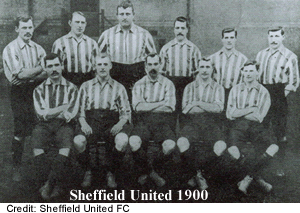 In the final decade of the previous century many professional teams changed their colours frequently but now the leading clubs were becoming firmly identified with specific colours which are familiar today. Bolton Wanderers and Preston North End wore plain white shorts with navy knickers, Derby County had settled on white shirts and black knickers in 1895 after trying out various combinations of white, black, cardinal red and dark blue. Sunderland, Sheffield United, Newcastle United, West Bromwich Albion, Notts County and The Wednesday were all wearing striped shirts in familiar colours.
In the final decade of the previous century many professional teams changed their colours frequently but now the leading clubs were becoming firmly identified with specific colours which are familiar today. Bolton Wanderers and Preston North End wore plain white shorts with navy knickers, Derby County had settled on white shirts and black knickers in 1895 after trying out various combinations of white, black, cardinal red and dark blue. Sunderland, Sheffield United, Newcastle United, West Bromwich Albion, Notts County and The Wednesday were all wearing striped shirts in familiar colours.
Several other sides would adopt the colours we associate them with today during this period. Manchester United dropped their white tops with navy knickers in favour of red shirts and white knickers when they changed their name from Newton Heath in 1902 while Everton first wore royal blue shirts in 1901. Celtic's iconic green and 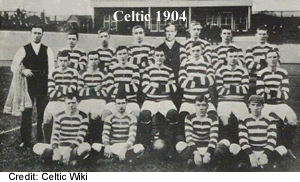 white hoops appeared in 1904, a strip that has become one of the most famous and recognisable in the world.
white hoops appeared in 1904, a strip that has become one of the most famous and recognisable in the world.
At the Football League AGM in 1904 the secretary of Liverpool FC, John McKenna put forward a proposal that would require every  team in the competition to play in red shirts or jerseys and white knickers at home while visiting sides would wear white tops and dark knickers. The motion was defeated and you might have thought that would have been the end of the matter but in 1906 McKenna proposed the motion again. It was once more roundly defeated but had it been successful, this article would end here.
team in the competition to play in red shirts or jerseys and white knickers at home while visiting sides would wear white tops and dark knickers. The motion was defeated and you might have thought that would have been the end of the matter but in 1906 McKenna proposed the motion again. It was once more roundly defeated but had it been successful, this article would end here.
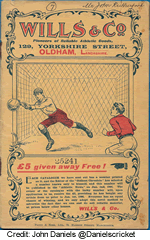 It is evident from catalogues dating from the early 1900s, that supplying football kit had become a thriving industry dominated by the Lancashire garment manufacturers. Wills & Co of Oldham hit upon a novel marketing plan, sending out numbered catalogues. The owner of the winning lucky number to be published in the Oldham
It is evident from catalogues dating from the early 1900s, that supplying football kit had become a thriving industry dominated by the Lancashire garment manufacturers. Wills & Co of Oldham hit upon a novel marketing plan, sending out numbered catalogues. The owner of the winning lucky number to be published in the Oldham 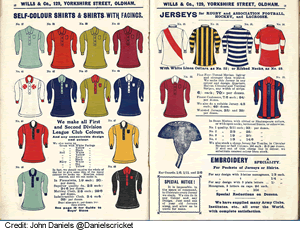 Chronicle on 2 January 1906 would, on application, be sent £5, a princely sum at the time worth £753 at today's prices. Wills boasted that they could make all First and Second Division club colours "and any conceivable design and colour." Prices ranged from 8/3 (£62 at today's prices) for a dozen cheap jerseys for youths to top of the range four-thread merino wool at 70/- (£528) and finest cashmere at 84/- (£633) a dozen. Middle of the range flannelette shirts in four different weights of cotton could be had for between 20/- (£150) and 38/- (£286).
Chronicle on 2 January 1906 would, on application, be sent £5, a princely sum at the time worth £753 at today's prices. Wills boasted that they could make all First and Second Division club colours "and any conceivable design and colour." Prices ranged from 8/3 (£62 at today's prices) for a dozen cheap jerseys for youths to top of the range four-thread merino wool at 70/- (£528) and finest cashmere at 84/- (£633) a dozen. Middle of the range flannelette shirts in four different weights of cotton could be had for between 20/- (£150) and 38/- (£286).
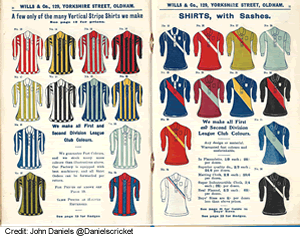 The range of designs available illustrates just how far garment technology had advanced with stripes in any width, hoops, quarters, halves and sashes available in any combination of colours all available. Wills offered to embroider monograms to order and if you could not find your desired top in their catalogue, you could send them a sample of your old team shirt and they would give you a quotation for making up a new
The range of designs available illustrates just how far garment technology had advanced with stripes in any width, hoops, quarters, halves and sashes available in any combination of colours all available. Wills offered to embroider monograms to order and if you could not find your desired top in their catalogue, you could send them a sample of your old team shirt and they would give you a quotation for making up a new 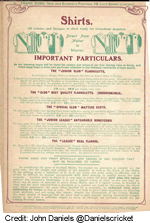 set.
set.
A rival company, Frank Sugg of Liverpool, emphasised the quality of the fabric used in the manufacture of their products. No less than 40 yards of material went into making a dozen Sugg shirts and the customer is warned that rival companies might use lighter cotton or wool. While these may feel the same to the uninitiated, these products would "be reduced very 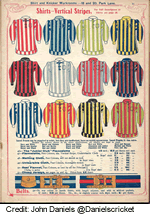 considerably in value as well as cost." Sugg's "Junior League" shirts were, we are informed, untearable, colourfast and so strong that they could be worn for four or five seasons. Given how washed out and faded the kit worn by even the biggest clubs appears in many photographs of the period we must conclude that club secretaries generally went with cheaper options or Frank Sugg was overstating the virtues of his products.
considerably in value as well as cost." Sugg's "Junior League" shirts were, we are informed, untearable, colourfast and so strong that they could be worn for four or five seasons. Given how washed out and faded the kit worn by even the biggest clubs appears in many photographs of the period we must conclude that club secretaries generally went with cheaper options or Frank Sugg was overstating the virtues of his products.
A rather nice feature of the period, which has completely disappeared, is the inclusion of belts in some of these early catalogues, available to match your club's colours.
(Catalogue images are scalable - click on the image to view a larger version.)
The regulations that required players to keep their knees covered were relaxed in 1904 but it is evident from team photographs that knickers were becoming shorter before that, presumably affording more freedom of 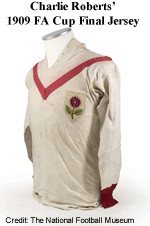 movement. Shirts and shorts were fairly close fitting and made from tough,
natural fibres. Socks were initially self-coloured but additional design features such as cadet stripes, rings and contrasting turnovers began to appear early on. The main stocking colour was always dark
(black, navy, red or blue). Shin pads were now worn inside the stockings.
movement. Shirts and shorts were fairly close fitting and made from tough,
natural fibres. Socks were initially self-coloured but additional design features such as cadet stripes, rings and contrasting turnovers began to appear early on. The main stocking colour was always dark
(black, navy, red or blue). Shin pads were now worn inside the stockings.
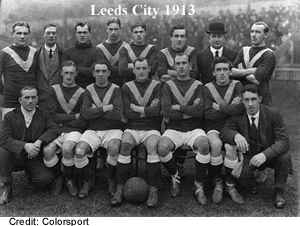 In 1909 Manchester United met Bristol City in the FA Cup final. Competition rules required both teams to change when colours clashed so both had special tops made for the final. Bristol wore blue with the coat of arms of the city on the left breast while United turned out in a novel white top with a bold red chevron and the Lancashire Rose embroidered on the left breast. This innovative design was quickly copied and several teams appeared in their own versions in the following seasons, including Clapton Orient, Glossop, Birmingham, Leeds City and Airdrieonians, for whom the design became their signature strip, worn by the original club until their demise in 2002 and by their successor.
In 1909 Manchester United met Bristol City in the FA Cup final. Competition rules required both teams to change when colours clashed so both had special tops made for the final. Bristol wore blue with the coat of arms of the city on the left breast while United turned out in a novel white top with a bold red chevron and the Lancashire Rose embroidered on the left breast. This innovative design was quickly copied and several teams appeared in their own versions in the following seasons, including Clapton Orient, Glossop, Birmingham, Leeds City and Airdrieonians, for whom the design became their signature strip, worn by the original club until their demise in 2002 and by their successor.
It was also in 1909 that the Football League required goalkeepers to wear distinctive tops to help referees make them out in a scrum of players for the first time - previously they wore the same tops as outfield 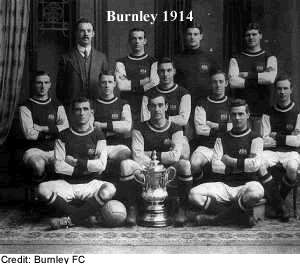 players. At first these had to be blue or red but given the number of teams playing in these colours it was soon realised this was impractical and green jerseys became standard. In Scotland deep yellow was favoured.
players. At first these had to be blue or red but given the number of teams playing in these colours it was soon realised this was impractical and green jerseys became standard. In Scotland deep yellow was favoured.
Burnley had worn all sorts of colours since their formation in 1882 but in 1900 they settled on green shirts and white knickers. Success eluded the team and in an effort to improve their fortunes their manager, John Howarth agreed with the directors to adopt the colours of Aston Villa, then league champions. Wearing their new jerseys, the team won their first major honour in 1914, beating Liverpool in the FA Cup final. The players wore the coat of arms of the Prince of Wales on their tops that day, a privilege granted them after Prince Edward visited Turf Moor in in 1886. Edward, now King Edward VII, attended the match and presented the trophy to the winning captain.
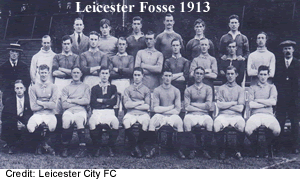 Plain jerseys and shirts were the most common design throughout this period - almost half of the members of the Football League sported plain tops when competition was suspended in 1915. These featured collars of various kinds but
Plain jerseys and shirts were the most common design throughout this period - almost half of the members of the Football League sported plain tops when competition was suspended in 1915. These featured collars of various kinds but 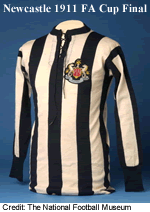 self-coloured or contrasting lace-up crew necks became increasingly common.
self-coloured or contrasting lace-up crew necks became increasingly common.
Stripes were the second most popular design in this period. The narrow, one-inch versions had disappeared, and two- or three-inch stripes were now most common, being easier to make out from a distance.
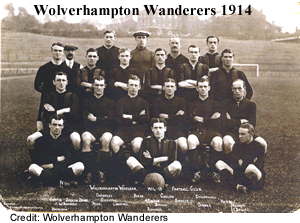 Wolverhampton Wanderers preferred wider stripes in their now traditional old gold and black. Their strip appears very dark in photographs of the period and more than a few team groups show players in their white change shirts as they would practically disappear when photographed against a dark background. This was due to a quirk of the orthorgraphic film stock widely used at the time. This was over-sensitive to light at the red/yellow end of the spectrum, causing these colours to be over-exposed (ie dark) while blues at the other end of the spectrum were under-exposed (ie pale). Whiie the Wolves' old gold was certainly a deep shade verging on brown it was not as murky as it appears in photographs like this one.
Wolverhampton Wanderers preferred wider stripes in their now traditional old gold and black. Their strip appears very dark in photographs of the period and more than a few team groups show players in their white change shirts as they would practically disappear when photographed against a dark background. This was due to a quirk of the orthorgraphic film stock widely used at the time. This was over-sensitive to light at the red/yellow end of the spectrum, causing these colours to be over-exposed (ie dark) while blues at the other end of the spectrum were under-exposed (ie pale). Whiie the Wolves' old gold was certainly a deep shade verging on brown it was not as murky as it appears in photographs like this one.
Ayr FC, one of the clubs that merged to form the modern Ayr United, wore very wide, offset stripes at the 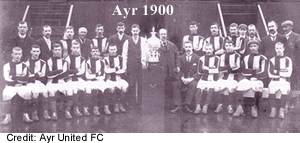 turn of the century. Huddersfield Town wore identical tops in their own light-blue and white colours in 1913-14, the first time the team appeared in stripes.
turn of the century. Huddersfield Town wore identical tops in their own light-blue and white colours in 1913-14, the first time the team appeared in stripes.
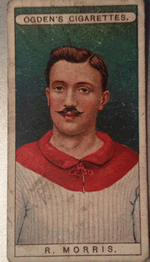 A novel design that emerged in this period was the contrasting yoke. First worn by Liverpool as a change strip at the turn of the century it became identified with Bradford City when they beat Newcastle United in the 1911 FA Cup final. It was worn by the Bantams until 1928 and was revived in the late 40s. Grimsby Town, Stockport County, South Shields, Middlesbrough and Motherwell were among the teams that wore
A novel design that emerged in this period was the contrasting yoke. First worn by Liverpool as a change strip at the turn of the century it became identified with Bradford City when they beat Newcastle United in the 1911 FA Cup final. It was worn by the Bantams until 1928 and was revived in the late 40s. Grimsby Town, Stockport County, South Shields, Middlesbrough and Motherwell were among the teams that wore 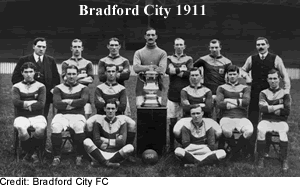 this style.
this style.
A rather different design was adopted by Huddersfield Town in 1910. In their case the yoke ran horizontally between the shoulders rather than following an arc. Middlesbrough wore their own distinctive version from 1913 until 1936 which were described as "epaulettes."
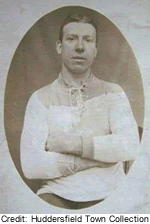 The Football League was suspended at the end of the 1914-15 season for the duration
of the Great War. Some clubs continued to play with official sanction
in order to boost civilian morale but were forbidden to pay
The Football League was suspended at the end of the 1914-15 season for the duration
of the Great War. Some clubs continued to play with official sanction
in order to boost civilian morale but were forbidden to pay 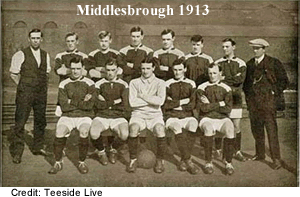 players. As a great many footballers had joined up, teams were severely depleted and many closed down. In Scotland
the First Division continued but the Scottish Second Division was suspended
and it appears that the members were disenfranchised
around 1917.
players. As a great many footballers had joined up, teams were severely depleted and many closed down. In Scotland
the First Division continued but the Scottish Second Division was suspended
and it appears that the members were disenfranchised
around 1917.
The production of sportswear had a low priority as the garment industry focussed on the production of uniforms, not only for the armed forces but also for the large numbers of women who went to work in factories, shipyards and on the land while the men went off to fight. The clubs that carried on generally continued to use the kit they wore in 1914-15 which, by the time hostilities ended, would have been in a sorry state.
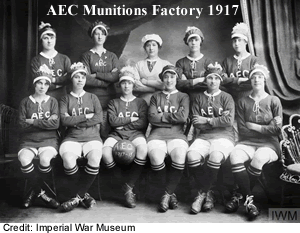 An unexpected consequence of the war was a boom in women's football. Although women had been playing the game since 1894 they did not have the support of the British football associations. Over 900,000 women went to work in the munitions factories alone where organised football was encouraged as a way to boost morale and maintain fitness. Matches often attracted large crowds which irritated the FA more than somewhat. In 1921, under the pretext that "the game of football is quite unsuitable for females and ought not to be encouraged," the Football Association banned women from playing on their members' pitches. It would take 50 years for the FA to relent and it was not until 2008 that they issued an apology for the ban.
An unexpected consequence of the war was a boom in women's football. Although women had been playing the game since 1894 they did not have the support of the British football associations. Over 900,000 women went to work in the munitions factories alone where organised football was encouraged as a way to boost morale and maintain fitness. Matches often attracted large crowds which irritated the FA more than somewhat. In 1921, under the pretext that "the game of football is quite unsuitable for females and ought not to be encouraged," the Football Association banned women from playing on their members' pitches. It would take 50 years for the FA to relent and it was not until 2008 that they issued an apology for the ban.
© Dave Moor (2023)